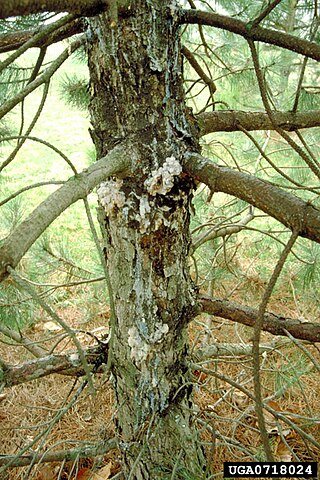
Synanthedon culiciformis, known as the large red-belted clearwing, is a moth of the family Sesiidae. It is found in the Palearctic and Nearctic realms.

Synanthedon tipuliformis, known as the currant clearwing, is a moth of the family Sesiidae. It is endemic to the Palearctic realm, but is an invasive species in the Nearctic realm and the Australasian realm.
Synanthedon cupreifascia is a moth of the family Sesiidae. It is known only from locations near Mackay in Queensland.

Synanthedon is a genus of moths in the family Sesiidae.

Synanthedon pini, the pitch mass borer, is a moth of the family Sesiidae. The pitch mass borer occurs on spruce and pine in eastern North America. It does not kill trees, but the pitch-filled larval tunnels in the wood cause defects in the lumber.

Synanthedon rileyana, the horsenettle borer or Riley's clearwing moth, is a moth of the family Sesiidae. It is found in the United States, including Arkansas, Arizona, Missouri, Oklahoma, North Carolina and Pennsylvania.
Synanthedon squamata is a moth of the family Sesiidae. It is known from Malawi.
Synanthedon beutenmuelleri is a moth of the family Sesiidae. It is known from the Republic of the Congo.
Synanthedon monozona is a moth of the family Sesiidae. It is known from South Africa.
Synanthedon platyuriformis is a moth of the family Sesiidae. It is known from South Africa.
Crinipus pictipes is a moth of the family Sesiidae. It is known from Zambia.
Synanthedon gabuna is a moth of the family Sesiidae. It is known from Gabon.
Synanthedon guineabia is a moth of the family Sesiidae. It is known from Equatorial Guinea.
Synanthedon nuba is a moth of the family Sesiidae. It is known from the Republic of the Congo and Gabon.
Synanthedon pauper is a moth of the family Sesiidae. It is known from Cameroon.

Synanthedon formicaeformis, the red-tipped clearwing, is a moth of the family Sesiidae and can be found in all of Europe, the eastern Palearctic realm, and the Near East. The larvae sometimes form pear-shaped galls on willows. It was first described by Eugenius Johann Christoph Esper in 1783.

Synanthedon stomoxiformis is a moth of the family Sesiidae. It is found in most of Europe and the Middle East.

Synanthedon cephiformis is a moth of the family Sesiidae. It is found in Central Europe and Eastern Europe.

Synanthedon scoliaeformis, the Welsh clearwing, is a moth of the family Sesiidae. It is found from almost all of Europe, east through Russia to Japan.

Synanthedon spuleri is a moth of the family Sesiidae. It is found from France to Turkey and Georgia. In the south, it is found in southern and eastern Europe. In the north, the range extends to the line Paris-southern Germany.












